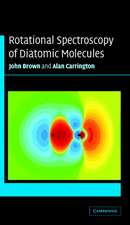Tandem Mass Spectrometry of Lipids: New Developments in Mass Spectrometry, cartea 4
Autor Robert C. Murphyen Limba Engleză Hardback – 14 dec 2014
The emerging field of lipidomics has been made possible because of advances in mass spectrometry, and in particular tandem mass spectrometry of lipid ions generated by electrospray ionization. The ability to carry out basic biochemical studies of lipids using electrospray ionization is predicated upon understanding the behaviour of lipid derived ions following collision induced decomposition and mechanisms of product ion formation. During the past 20 years, a wealth of information has been generated about lipid molecules that are now analysed by mass spectrometry, however there is no central source where one can obtain basic information about how these very diverse biomolecules behave following collisional activation.
This book brings together, in one volume, this information so that investigators considering using tandem mass spectrometry to structurally characterize lipids or to quantitate their occurrence in a biological matrix, will have a convenient source to review mechanism of decomposition reactions related to the diversity of lipid structures.
A separate chapter is devoted to each of seven major lipid classes including fatty acids, eicosanoids and bioactive lipid mediators, fatty acyl esters and amides, glycerol esters, glycerophospholipids, sphingolipids, and steroids. Mechanistic details are provided for understanding the pathways of formation of major product ions and ions used for structural characterization. In most cases specific ancillary information has been critical to understand the pathways, including isotope labeling and high resolution analysis of precursor and product ions. For a few specific examples such data is missing and pathways are proposed as a means to initiate further mass spectral experiments to prove or disprove pathway hypotheses. While this work largely centres on the lipid biochemistry of animal (mammalian) systems, general principles can be taken from the specific examples and applied to lipid biochemistry found in plants, fungi, prokaryotes and archeal organisms.
Preț: 1125.97 lei
Preț vechi: 1309.27 lei
-14% Nou
215.45€ • 225.55$ • 178.27£
Carte tipărită la comandă
Livrare economică 05-19 aprilie
Specificații
ISBN-10: 1849738270
Pagini: 293
Ilustrații: colour illustrations
Dimensiuni: 165 x 239 x 28 mm
Greutate: 0.73 kg
Editura: Royal Society Of Chemistry
Seria New Developments in Mass Spectrometry
Notă biografică
Textul de pe ultima copertă
The emerging field of lipidomics has been made possible because of advances in mass spectrometry, and in particular tandem mass spectrometry of lipid ions generated by electrospray ionization. The ability to carry out basic biochemical studies of lipids using electrospray ionization is predicated upon understanding the behaviour of lipid derived ions following collision induced decomposition and mechanisms of product ion formation. During the past 20 years, a wealth of information has been generated about lipid molecules that are now analysed by mass spectrometry, however there is no central source where one can obtain basic information about how these very diverse biomolecules behave following collisional activation. This book will bring together, in one volume, this information so that investigators considering using tandem mass spectrometry to structurally characterize lipids or to quantitate their occurrence in a biological matrix, will have a convenient source to review mechanism of decomposition reactions related to the diversity of lipid structures.
A separate chapter is devoted to each of seven major lipid classes including fatty acids, eicosanoids and bioactive lipid mediators, fatty acyl esters and amides, glycerol esters, glycerophospholipids, sphingolipids, and steroids. Mechanistic details are provided for understanding the pathways of formation of major product ions and ions used for structural characterization. In most cases specific ancillary information has been critical to understand the pathways, including isotope labeling and high resolution analysis of precursor and product ions. For a few specific examples such data is missing and pathways are proposed as a means to initiate further mass spectral experiments to prove or disprove pathway hypotheses. While this work largely centres on the lipid biochemistry of animal (mammalian) systems, general principles can be taken from the specific examples and applied to lipid biochemistry found in plants, fungi, prokaryotes and archeal organisms.
























